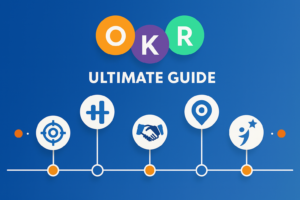The term “Human Resource Management” (HRM) describes the process of developing an organization’s human capital. HRM puts the human aspect of the organization at the forefront, treating them as an asset worth investing in and developing.
We must remember that HRM is a continuous cycle so it truly never ends, starting off with an analysis of a required job in an organization and ending with ensuring overall employee development and satisfaction. The broad categories that define the HRM process are:
– Staffing.
– Defining work.
– Designing job structure.
– Compensation and employee benefits.
The detailed steps included in the HRM process are:
– Assessing the requirement of a new job.
– Planning job description.
– Identifying the right skill set and education for the role in consideration.
[optin-monster-shortcode id=”ji9msz3zadte5hioc9e0″]
– Recruitment of best-fit talent.
– Orientation/Induction.
– Training and development.
– Assessing employee performance.
– Planning benefits.
– Grievance handling and dispute resolution.
– Clear communication within all employees.
The purpose of HRM in all organizations is primarily to; hire right candidates, continuously develop them, and retain these employees. HRM stands for proper and optimal use of available human resources in an organization. But out of all disciplines of management i.e. finance, supply chain, marketing, and human resource, the “human resource” is the most volatile and difficult domain to handle due to its major chunk being the “human” element.
The role of HR in organizations has grown exponentially over the past few decades, with employees now recognized as one of the most valuable resources. Businesses have come to understand the importance of hiring, developing, and retaining the right talent — and how these individuals directly contribute to profitability and long-term success — firmly establishing the idea of employees as true organizational assets.
Due to this, the importance of HRM process has also increased exponentially over the past few years, making it the most sought after department/skill an organization or a person can have. All organizations, regardless of size, are now implementing HRM software to reduce the investment of time and increase the ease of business. Evaluating HRM processes is time-consuming and labor-some work for human individuals.
Most organizations have implemented HRM software to ensure that there is a negligible margin of error in this process, which has contributed to the popularity of HRM software.
HRM software is an automated software – which automatizes most of the parts of HRM process; i.e. recruitment, employee management, payroll management, employee scheduling, learning & development management, training, performance evaluation, analysis of data, reporting of data and database collection & management etc. It is also an efficient way to centralize the entire HRM process and the data which it generates in this process.
The HRM software gathers all the information of individual employees in a centralized manner to make it easily assessable when the requirement arises, such as at the time of appraisal, training, or new job creation. If the benefit of HRM could be summarized in one sentence it’ll be to improve overall organizational efficiency.
Due to their popularity today there is a plethora of HRM software in the market catering to either all of HRM processes or some of its parts, but regardless the basic HRM software features remain the same. Some of these HRM software features are:
-
Improving HR efficiency
- By reducing the processing time and increasing the efficiency of different segments.
- Database collection.
-
Automated aid in recruiting
- Planning and posting jobs.
- Applicant tracking based on skill set requirement.
- Analyzing resumes.
- Interview scheduling.
- Aiding in the induction process.
- Collaborative recruiting.
- Using social media in hiring.
- Assigning KRA’s.
- Aiding in internal promotions.
-
Improvised tracking of employee data
-
Better and easy scheduling of employees
- Attendance management.
- Scheduling shifts.
- Leave management.
-
Performance evaluation
- Evaluating completion of KRAs.
- 360° evaluation review of performance.
- Performance tracking.
- Ease and efficient tracking of training/developmental activities required and their output.
- Automatic reporting.
-
Efficient and fast payroll management.
-
Better HR analytics and reporting from data gathered thus leading to better decision-making.
All these features make HRM software an essential part of organizations across the world. Apart from these features, there are other benefits of HRM software that prove to be of critical importance in aiding their popularity over the past few years.
The benefits are,
-
Highly efficient aid
- Being automated the chances of error in performing a task are minor.
- They give ease to access any information.
-
Cost-effective
- HRM software come at fairly reasonable prices, as compared to the entire team which was earlier used in their place.
- Also, their maintenance is easy and inexpensive.
-
Less time consuming
- Can access large quantities of information at once.
- Information can be easily gathered from various departments in an instant.
-
Easy and precise data collection
- Data collection is precise and aids in making informed decisions.
- Can easily compile and analyze reports based on the data collected throughout the years.
-
Strategic decisions
- Practical and strategic decisions like; making new job descriptions, selecting the type of training to be given, etc. can be made, by assessing the past trends shown by the data collected.
-
Improvised communication
- The data collection like, contact information, past work, and projects undertaken by employees can be easily distributed amongst the team.
-
Ease of data recovery
- An automated system helps in the ease of data backup and recovery, which in turn aids in the efficient overall process.
Evident that HRM software has become a critical and important part of an organization, which easily plays a vital role in its success.

